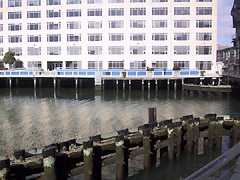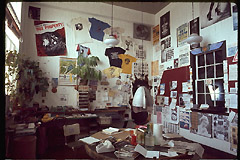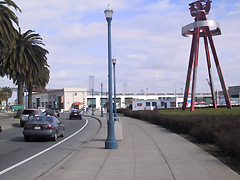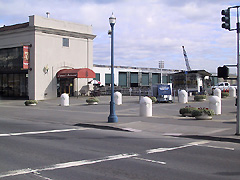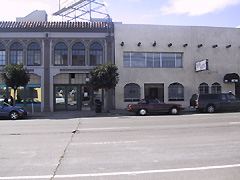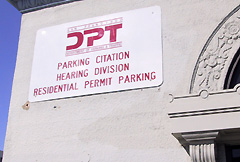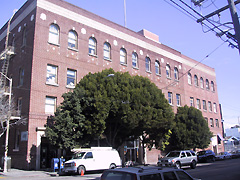
Walking through San Francisco’s video past by Luke Matthew Hones
Some of us haven’t changed our clothes or haircuts in 15 years. But since the earthquake of 1989 San Francisco has undergone an extreme makeover. There are the obvious touches: South Beach neighborhood, SBC Park, the Main Library, the torn down Embarcadero Freeway and the Embarcadero Street and railway that have replaced it, SFMOMA and Yerba Buena Center for the Arts. Then there are the less obvious changes, like new tenants through which the haunts of countercultural collectives been converted into the likes of the offices of the Department of Parking and Traffic.
All of which underlines the irony of going on a journey to find San Francisco’s video past. If you’ve spent some time around artists who’ve spent some time around video you hear the word “ephemeral” a lot. Many early artists reveled in the idea that their work would only last the run of a gallery show. Now you find the workshops where they have created their art are just as will-o-wisp as their art. Live/work lofts, ballparks, and an unusual number of fires have obscured the San Francisco video spaces of the 1960s, 1970s and 1980s. Let’s go looking for them.
Our tour starts on Potrero Hill, close to the California College of the Art’s converted bus hangar campus and the Bottom of the Hill bar.
Home base at the End of the Line
Bay Area Video Coalition (BAVC), 1111-17th Street
Call me anal, but if I were designing San Francisco’s cityscape, the numbered streets, like 2nd through 30th, would run parallel to each other. But as you travel south of Market Street away from downtown, Mission Street and 3rd Streets, independent of one another, make elbow turns, causing some unusual intersections at the foot of Potrero Hill. It was always confusing to give directions to BAVC when it was on Potrero Hill: “It’s up one block from the corner of 7th and 16th Streets.”
BAVC occupied a converted bachelor pad at the corner of 16th and Mississippi Streets from the early 1980s to the mid-1990s. This location was literally a short walk away from the turnaround for Muni’s 22 Filmore bus line and worlds away from the bustle of the Mission District or downtown.
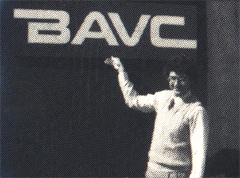
BAVC's old logo
During this early time BAVC had a logo that rivaled MUNI’s for a 70s ugly award. In the mid-90s new facility services were added and weekends resembled episodes of “This Old House” in which storage spaces became classrooms, closets became hallways, doorways were closed up turning rooms into sound booths and staff got squeezed on top of one another. In 1996 BAVC outgrew the bachelor pad and moved to 2727 Mariposa Street, right next to KQED.
The San Francisco Video Festival
San Francisco Video Festival (SFVF), 1270-17th Street
Doubling back down 17th Street 2 blocks you come to the former San Francisco Video Festival gallery which was a happening place from 1980 – 1986. According to Steve Seid, video curator at Pacific Film Archives and former Video Festival curator, the SFVF morph’d out of a Civic Center event called “The Public Eye” that started in the 70s. The video festival’s gallery on 17th Street mounted many shows, branching out from video into mixed media, but the best remembered show seems to be “The Miniature Golf Exhibit,” which included miniature golf holes designed by artists. Howard Fried’s entry was minimalist – a concrete slab with no hole, Phil Garner’s hole was on the wall, Tony Labat’s hole was behind a curtain, in the dark. Paul Kos built his hole on a 15’ x 15’ slab of ice and to get out on the ice you had to don crampons. If you left your ball on the ice for a week or so the ice would melt around the ball so that no matter where it had landed it would be in the hole.
The SFVF’s move from Potrero Hill to South of Market pretty much killed it, but it continued for a little while on Howard near 9th St.
The Great San Francisco Video Fire, part I
One Pass Video, 185 Berry Street, China Basin Building.
One block north and a long walk east down 16th street, past UCSF’s new Genentech Hall, takes you to 3rd Street. Looking north down 3rd you see SBC Park.
All the new development in this area disguises what was, less than a decade ago, a martian landscape of huge dirt lots and seedy warehouses. Across 3rd street from SBC Park, flanked by two drawbridges, is 185 Berry Street, the China Basin Building. For a long while, from the 1970s to 1990s, it was the home of a truly legendary center for video and video art: One Pass Video.
The name was a boast and One Pass lived up to it for many years. One Pass was where artists like Max Almy created visually complex work because, well, One Pass had the gear that allowed him to make it. They even owned the earliest nonlinear editor, a Montage, which was a prehistoric version of Final Cut Pro. The setup included an editing console/minicomputer that controlled 17 Betamax videocassette players. When you wanted to view a rough cut, all 17 would fire up, showing you a different part of the finished tape in real time.
One Sunday morning in 1991 a fire tore through the building, gutting the facility which once housed One Pass, though One Pass itself had moved on long before that. While it still had a preeminent spot in the video production community, One Pass had been sold to Unitel and renamed Editel-SF. After the fire, Unitel decided not to rebuild Editel-SF and One Pass passed away with nary a whimper.
The Great San Francisco Video Fire, Part II
Ant Farm, Pier 40
At the foot of Townsend Street, just a few blocks from SBC Park, is Pier 40. Nowadays Pier 40 is in the center of the South Beach neighborhood, but fifteen years ago Pier 40 was surrounded by empty lots and old buildings. And twenty five years ago pier 40 was where you would find Curtis Schreier, Doug Michels and Chip Lord (aka Ant Farm) a collective that combined architecture and media to create such works of art as “The Eternal Frame,” “Cadillac Ranch,” and “Media Burn.”
In 1978 a fire swept through Pier 40 driving Ant Farm out. Chip Lord says: “After the fire they tore down the damaged structure, but left the undamaged continuation of Pier 40. …(T)he Cafe at Pier 40…has the feeling of the Ant Farm space—a two story loft with windows on the embarcadero. The Java House is a greasy spoon relic that is still there (and pretty much unchanged), but the surroundings have been radically gentrified. (I)n the mid-seventies the whole area was warehouses in various stages of disrepair and disuse. There was a bar on Townsend, a few doors down from the Embarcadero - "Bouncers" and walking by it at 8:00 AM there was sure to be a full bar of workers fueling up for the day.”
“At Pier 40 take a look at the Bike hut and say hello to Victor Vesey who manages it. He runs a youth training program that teaches inner city kids how to fix bikes and repair flats, and I think of him as carrying on some of the Ant Farm attitudes towards the automobile and urban life.”
After the fire the group disbanded. Fortunately much of their work has been saved and restored from the fire.
Public Broadcasting when Public Broadcasting meant Public Broadcasting
The National Center for Experiments in Television, 288-7th Street
Long ago, before the commercials and cooking shows, KQED was lauded in Gene Youngblood’s book Expanded Cinema for its active role in fostering the National Center for Experiments in Television (NCET). But NCET was no “Sesame Street,” and the synthesized video of NCET (“Painting in Time”) would only survive on the airwaves a few short years. It was at NCET where Stephen Beck built and used his legendary video machines: the Direct Video Synthesizer and Video Weaver. During this time when Moog and Buchla ruled, the Center was the place to be. The 7th Street address was the Center’s move out of KQED, and a step into the mist of history.
A side trip to Bryant and 8th will take you to the big blue building that used to be KQED.
The Great San Francisco Video Fire, Part III
Artists Television Access (ATA), 220-8th Street
Just around the corner is the former home of Artists’ Television Access. On ATA’s history website artist Fred Rinne writes:
“There was a noise band playing at ATA on Halloween night (1986) who were particularly grating and noxious; most of the audience were chased away. The band was grinding and screeching away and had a tape machine going to document their concert. Though I wasn't at the show, I got a chance to hear the tape later. In the midst of the "music", John Martin runs up to the band, yelling "Get out of here! There is a fire"... and then you hear the band making a hasty exit. After a minute you hear the flames crackling like a loud barbecue. How often do you hear a building burning from the inside? Chunks of ceiling coming down could be heard hitting the drum set. One of the most haunting parts is hearing the fire engine down the street just like you always do but from the perspective of the building being burnt.
The tape kept rolling even though everyone was evacuated. Next you hear the firemen chopping everything with axes, and the sound of extinguishers and hoses. After the fire is under control (one assumes) one of the fireman comes up to the band area and can be heard doing an impromptu drum solo. I was there the next day and Marshall gave me a tour. We swatted around broken glass like hockey pucks amidst the black ash and inches of water. He showed me a stack of videotapes that were fused by the heat into a human head shape and said "these were all my videos, all my work..." It's not often one's lifework gets condensed down into one convenient sculpture.”
Hippy-tech
Optic Nerve, 1380 Howard Street
Optic Nerve was located in the basement of Project One, a technically sophisticated collective that hosted, among other things, a minicomputer and the technicians to bring computing power to the people. This was a time, the early 70s, when pocket calculators cost $500-2,000, the first personal computer (the Altair) was still 2 to 3 years away from being announced by Popular Mechanics, and the PC was a decade away from any critical mass.
Stewart Brand (of Whole Earth magazine) wrote about Project One for Rolling Stone in December, 1972: “Another scheme in the works involves the people around Steve Beck at the National Center for Experiments in Television a few blocks away. Steve has built the world's first real-time video synthesizer - the video equivalent of the Moogs, Buchlas, and Arps of music synthesis. It's a natural to link up with a computer. The current plan is for Steve and his equipment to move into the basement…(m)aybe the video link-up will give us some higher levels of Spacewar on the way to exploring new territory entirely.”
The video group that joined Project One called itself Optic Nerve and their first videos documented the collective.
Real Public Broadcasting
Channel 25, 15th and Folsom Street
Traveling from south of Market towards the Mission there is really no way to bypass the former Far West Labs building, the location for San Francisco public access for most of the 80s and 90s.
15th and Folsom wasn’t the first location for SF’s public access TV station, but it is one that is burned in the herd memory of a generation of public access producers. Channel 29 was once channel 25, and its studios were 6 floors up in this brick building (now occupied almost exclusively by UCSF).
The mid 80s were a heady time for public access. The equipment was worn out and the volunteers weren’t that good at getting shows started on time (as a one-time volunteer I sympathize since a lot of shows ran over the time limit). But what we lacked in quality we made up for in controversy. These were the days of White Power programming: “Race and Reason” and the anti-“Race and Reason” pickets. Mainstream media had a good time either making fun of “vanity TV” or expressing horror at what was (and is) the city’s only electronic soapbox. Public access was the haven for crackpots, perverts, egotists, and, oh yes, the community.
My favorite show to work on was Dave (aka Dog, lead vocalist for the Longshoremen) Swann’s “Doghouse” which had a theme song by Voice Farm and appearances by Debra Iyall, Frank Jello Biafra, Jim Morton (editor of RE/Search Publication’s “Incredibly Strange Films”) and Frank Moore.
At a certain point San Francisco decided to take public access seriously. The management of the station was taken away from the cable operator (Comcast? ATT? Viacom? Who can remember?) and given to a nonprofit headed by tireless advocate Zane Blaney.
FAF and BAVC in the same building?
Redstone Building,
Tired of going back and forth between Film Arts and BAVC? There was a time when both organizations were in the same building—the ever funky, ever wonderful Redstone building on 16th Street. During the late 70s and early 80s both media arts centers occupied spaces in the Redstone—Film Arts and BAVC on the 2nd administrative offices and BAVC the editing facilities on the mezzanine. Steve Seid, current video curator of the Pacific Film Archives and BAVC alum writes: “I watched David Ireland renovate the Capp Street house from my window.” Gail Silva of FAF says her view was of a gas station on South Van Ness.
Video Free America, 442 Shotwell Street
Video Free America was founded in 1970 by videographer Skip Sweeney as a place of artistic foment dedicated to pioneering the new genre called “video art.”
At over 30 years of age VFA is the oldster of video art workspaces. Oddly, it also seems to be the only place that kept the same address.
There is an interesting facsimile of a letter in VideoCity, the magazine about the San Francisco video scene published by Radical Software in 1973. It is an invitation to video artists to join video art packages with the name: Tapes from All Tribes “a realistic program for the distribution of half-inch video tapes.” This distribution brainchild was put forward by Video Free America in collaboration with New Line Cinema. The letter is signed by Bob Shaye of New Line in which he writes: “Soooo…if the notion of your work widely and profitably distributed doesn’t threaten your counter-cultural credential, you should submit copies of tapes…” Same pitch he made to Peter Jackson?
The Great San Francisco Video Fire, Part IV
Cow Palace, Geneva and Santos
You probably won’t be able to walk to the Cow Palace. Instead, the Cow Palace website suggests this route: “At 24th and Mission take BART’s San Francisco/Millbrae BART line to Balboa Park station. From Balboa Park station take the #15 Muni bus to the Cow Palace bus stop at Santos Street.”
On July 4, 1975, after a rousing speech by John F. Kennedy, the Ant Farm drove the “Phantom Dream Car” through a wall of TVs for a publicized media event in the parking lot at Cow Palace. Okay, it wasn’t John F. Kennedy, but artist-president Doug Hall and the Phantom Dream Car was a modified ’59 El Dorado. But what a spectacle. The looks on the local newscasters faces, and confused remarks suggest a double meaning for the event’s name: “Media Burn.” Looking at footage of the event it is hard to judge the number of spectators, but the crash is burned in many of our minds.
Finding yourself in an empty parking lot on the outskirts of San Francisco after a long day of chasing the past you know you have just two more things to do: Eat something and get home. Good luck with both.
